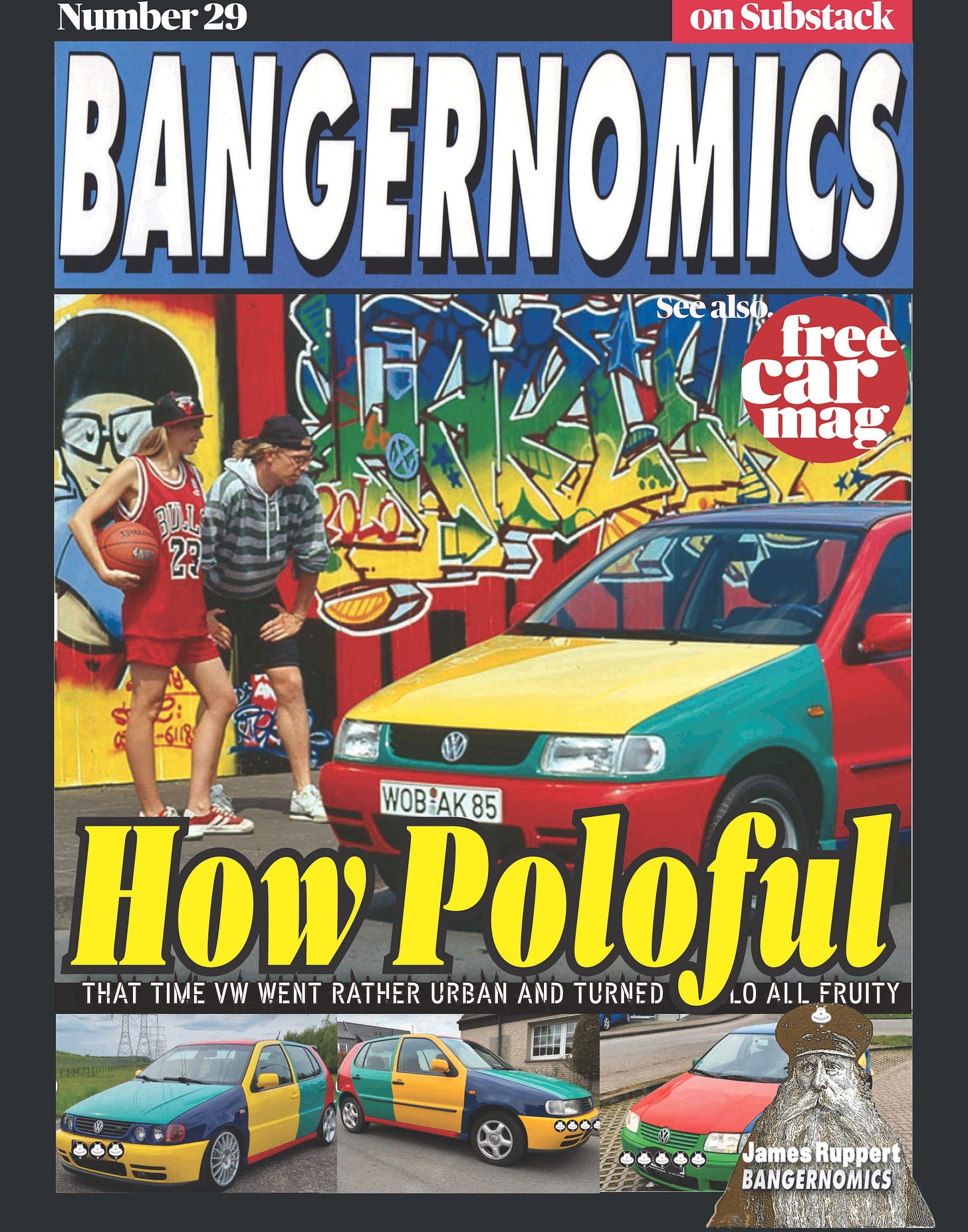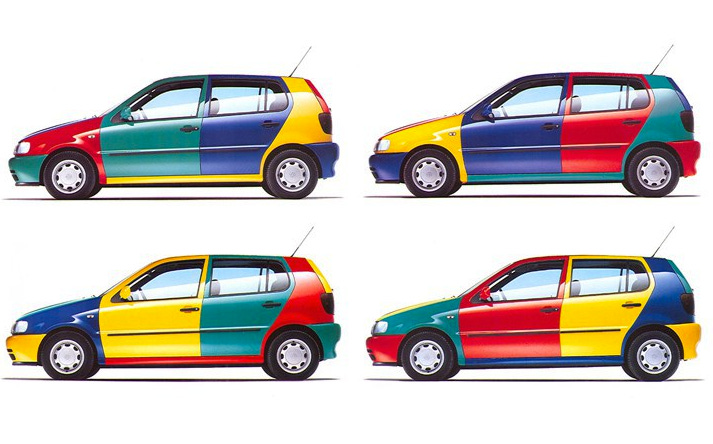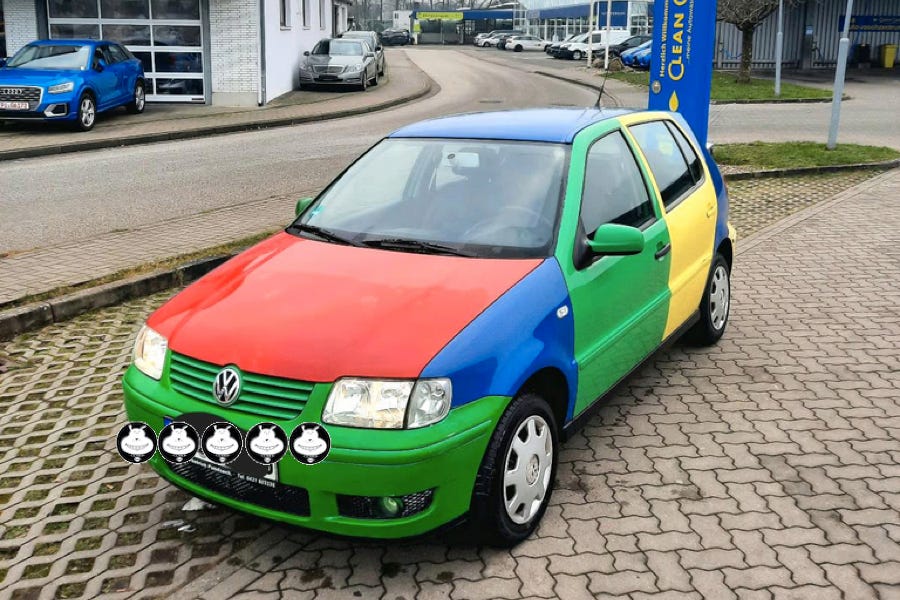Colour blindness is a wonderful thing and absolutely essential if you are going to buy a used car. Not caring very much about what hue your new ride is gives you a much wider choice and most importantly you can then potentially save a few bob and it will be a smallish amount by making an unpopular choice.
Just how much difference colour makes really depends on the desirability of the car, model, age and all that stuff. When you get to the Bangernomics end of things then all bets are off. Nothing really matters at all, only whether there is an MOT and few years left on the cambelt life.
The simple truth is that all the stress and worry has been taken out of the colour choice equation by making it all rather dull. Whereas ‘60s, ‘70s and even ‘80s car parks, actually come to think of it even some ‘90s open plan vehicular areas contained some quite funky sights. That is after all where the Polo Harlequin came from.
A brief History of the VW Polo Harlequin
The Harlequin wasn’t supposed to happen but Volkswagen ended up shifting 3,800 of them. In 1994 when VW introduced the third-generation Polo and ordering became easier with defined powertrain, equipment, options, and colour combinations. The internal colour code for these was Blue for engine and chassis, yellow for equipment, red for options, and green for paint colors. Some bright spark in dealer marketing decided that it would be a good idea to show their network how this works by making twenty multicolour Polos to show off at events.
When customers saw them, by accident or design, VW took them seriously and started a production run of 1,000 and dubbed Harlequin referring to the colorfully dressed characters from the Italian commedia dell'arte theatre.
Making one wasn’t simply mixing and matching parts, except it sort of was. Firstly they built four standard hatchbacks in blue, red, yellow, and mint green. Then the factory swapped the relevant parts, that would be the bonnet, tailgate, doors, bumpers, and mirrors.
The Polo Harlequin came in four mixes of colours and customers were not able to choose what part went where and had to wait for delivery to see which one they got. Inside, the Joker upholstery pattern incorporated all of the Harlequin colours. The steering wheel and gearshift knob were bright blue leather. A Blaupunkt Harlequin stereo was also part of the package, except that’s my little joke. The initial customers were the luckiest as the first 1,000 came with a numbered keyring and certificate.
Then the Harlequin idea also went international. In 1996, VW built 264 examples of the multi-coured Golf and sold them in America. They were a mix of Pistachio Green, Ginster Yellow, Tornado Red and Chagall Blue. Making it even more special, the green and blue were never available in North America.
….And back to the boring core story about Car Colour Stats
For the new car buyer, the fleet manager and any normie car owner boring colours are best. The theory has always been that unless you want to torpedo the future value of your car, or chances of selling it, then grey, silver grey, stardust silver rather than metallic heliotrope orange is the preferred option.
Indeed, non colours have done really well. There has been the resurgence of white in the last few decades as a socially acceptable colour after the original XR3/GTE spike in the ‘80s. Before then white really was only a reality as standard application to Cop and Corporation spec vehicles. That’s the reason why no one wanted it, even if that was a low maintainece experience, it would potentially knock 10-20% off the value.
Then there was black, ideally wipe clean metallic. Mostly on the executives that were otherwise silver grey. No one would want to go through the whole history of company car colours as they progressed from a swatch on a brochure to a piece of metal sprayed and stuck to the wall of the showroom, or even a flickering image on a reasonable resolution computer screen.
Potentially we can now embrace something more exciting: racing colours. Personally I do favour the classic fag packet liveries from the golden age of Formula One. Gold Leaf Team Lotus, JPS, Embassy Hill, Rothmans Porsche. As for much nicer smells, there was always the perfumed Yardley McLaren combination which I believe involved some green and the wonderful blue and red Gulf. Mind you, the red and white McLaren Marlboros were great too.
Of course you can wrap a car in just about anything these days including your face, which is a pretty frightening thought. But those chrome wraps and bright colours are all pretty funky which begs the question: just what colours would you, or do you wrap your car in? Here then are some suggestions based on what is being registered in Wales.
Anyway some analysis recently (never released and who knows you might find it a bit dreary, but this is quite genuinely an exclusive) of what’s being registered at the DVLA show an increasing number of new car owners are looking to drive around in a vehicle with a green paint job. The colour was way down the buyers’ charts four years ago but since then its popularity has more than trebled as more drivers went for that option.
Owners who plump for a green motor are said to be showing a love of nature, harmony and balance according to people who like to read into things a bit too much. Apparently, green-coloured cars are surging in popularity at the same time as government attempts to corral drivers into greener battery-powered motors appear to have stalled due to their high cost.
Official figures show that the most popular colours for new cars are rather subdued with grey, black and white making up the one, two, three of the most frequently chosen colours.
But further down the colour chart the more vibrant colours show more variation as drivers swing from one colour to another. The last few years have seen a strong surge in buyers opting for cars in green, yellow, purple and gold. While at the same time there has been a drop off in people wanting blue, red, brown, silver, pink and orange cars.
In five years the number of green cars being registered every year has shot up from 17,000 to 58,000. Dark shades of green on Land Rovers are thought to be partially responsible for the rise in numbers as well as more vivid shades of the colour popular on models such as the Ford Fiesta and the Fiat 500.
At the other end of the scale pink cars, loved by absolutely no normal person apart from the puppet Lady Penelope, have plummeted from 1,401 to just 336 last year.
The nation’s favourite car colour is grey, which colour psychologists say shows practicality and responsibility. There were 548,000 grey cars registered last year an increase of 11percent on the numbers four years ago.
In the same time frame the number of black cars being registered fell 3percent, white cars dropped by 12percent, blue cars by 13percent with red and silver seeing a 28percent decline.
Colours on the rise have seen purple surge by 62percent, gold by 154percent, yellow up 100percent and turquoise by 13percent.
My take is that subliminally green has become the new black. In the showroom the sheer range of hues on offer means it is no longer a starkly divisive choice. Green has become sexy and is the easiest way to prove to other road users that you ‘care’.
Neutral grey remains the company fleet buyer’s friend. It never causes financial trouble when the time comes to sell.
Private buyers given the freedom to express themselves are now going back to the ‘70s, hence the move towards purple and gold. This also accounts for the fact that most models are so similar in design, going out on limb with a lively colour is pure freedom of expression.
Shall we buy a green car? Or a Harlequin? Let’s go for a quick Kerbcrawl.
A multi-colour Harlequin of course, but we have to go to Europe and specifically Germany to find one. Here’s one for £9916 originally bought from Belgium in 2019 and then either spoilt rotten, or tastefully modded, depending on what you think. Without going into far too many Google translated details, the sellers has changed it from a 1.0 shopper into a 16 valve 1.4. Uprated brakes, gearbox, engine and sitting on OZ alloys. It’s done 288K kilometres. Slog likes the idea of this, but it is a Harlequin gone a bit too far, three Slogs.
Another private seller in Germany who has reduced the asking price of the 1997 with 50K miles from almost £6,000 to just below £5,000. It’s a four Slogger.
Finally a dealer in Hamburg with €1000 off a ‘96 with 122K kilometres making it just £2323. That’s a 5 Slogger.











Yes white was the colour of showroom death in my time and I even had a white 520i demo that they covered in stripes and a body kit to give it some showroom appeal. That did work!
Appreciate you taking the time to read it.